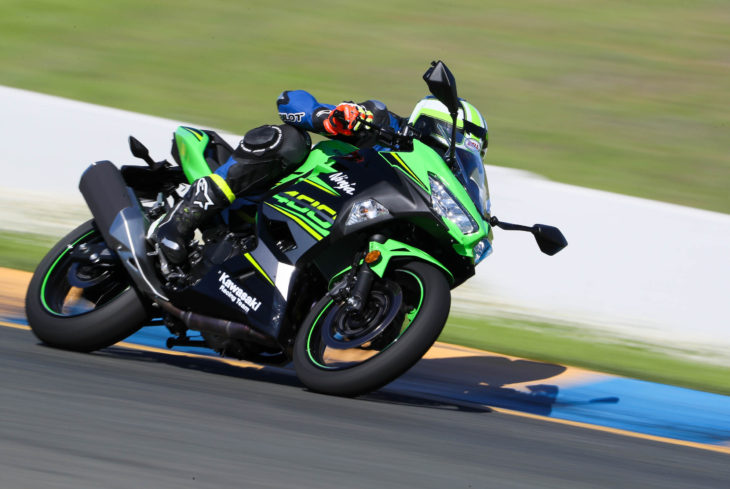
When it comes to sportbikes, Kawasaki has a rich history of building some of the best. This time the Green Team focuses its R&D effort on the most affordable member of the Ninja family, retiring the Ninja 300 in favor of a more versatile entry, with the new Kawasaki Ninja 400. And the best part? The MSRP remains unchanged, starting at $4,999.
Like Ducati, Kawasaki is known for pushing the displacement envelope in the never-ending quest to one-up the competition. And that’s just what it is doing in the red hot entry-level sportbike class. The Ninja 400 now boasts the largest engine in the segment … featuring a liquid-cooled 399cc Parallel-Twin.
Engine vitals include a bore/stroke ratio (70.0 x 51.8mm) and a compression ratio (11.5:1) which have increased giving it additional ‘oomph, particularly where riders need it the most. Where the old 300 was a tad anemic down low and in the mid-range, the 400 offers broader power so it reaches freeway speeds in a jiffy. At 65 mph, the engine pulls just over 6000 revs in top gear, with another 6000 rpm in reserve before redline. As one might expect, this new 33% larger motor is in a different league.
Rowing through the six-speed gearbox demonstrates smooth, precise shifting. The one-finger pull, cable-actuated clutch might appeal to new riders, while feeling almost too light for more experienced pilots who want more feel. On the other hand, the clutch’s slipper action function will be appreciated by everyone— helping to mitigate rear wheel chatter/instability while downshifting aggressively.
At lower rpm, the engine is smooth and devoid of vibration. But past 7000 rpm, vibes creep through the controls. But what do you expect for a bike that costs as much as some mid-grade mountain bikes? Rather than a knock, one could argue that the mild buzz makes the riding experience more immersive— especially for those looking to experience the real flavor of motorcycling.
Well-calibrated fuel injection affords pleasing throttle response that is neither too snatchy nor too soft – building confidence with the powertrain. There’s no adjustable engine power modes, nor traction control— but these are features we can easily live without on a bike displacing 399cc.
Ninja sportbikes are known for an exhilarating, high-revving engine note. These attributes are endowed in the entry-level Kawi, too. It breathes through a larger airbox that in typical Kawasaki fashion emits a throaty tone during acceleration. The higher the rpm, the better the sound, yet it isn’t enough to offend the senses or fellow motorists.
Contrary to the, at times, cookie-cutter instrumentation on competitors’ small-displacement machines, the new Ninja 400 gets a legible LCD, which uses white numbers on top of a black background. This setup not only proves easy to read, but it looks high-tech, too. A large, analog tachometer is front and center, next to a handy gear-position indicator (and clock).
The instrumentation also includes fuel and economy stats. During the course of our spirited, 100-mile ride through the hills of northern California’s Sonoma County, we registered an indicated 49 mpg. This gives a range estimate of 181 miles based on the 3.7-gallon capacity of the fuel tank. Although fuel capacity is down 0.8-gallon versus the outgoing 300, a more judicious application of the throttle could push range over 200 miles on the new model.
Considering the target customer, the entry-level Ninja has always had small riders in mind. While that continues, the Ninja 400’s cockpit sports better proportions in an effort to cater to both taller and shorter pilots. Specifically, the clip-ons and rearsets shift rearward. Seat height is unchanged at 30.9 inches and was deemed comfortable enough during our ride despite the tester’s 6′ frame.
The Parallel-Twin engine configuration makes for a slim mid-section, which makes it easier to get your feet planted at a stop. The front fairing appears wider— deflecting more air from the rider and adding a further layer of comfort behind the handlebar.
Body panel shapes more closely resemble the rest of the Ninja family and the tail section has been modeled after the top-dog of them all: Kawasaki’s supercharged H2. It also comes equipped with LED lighting front and rear which helps you see, and be seen on the road — a nice touch considering its MSRP. We didn’t get a chance to ride after dark, but we did ride across a dark tree canopied stretch of road and could see the head beams a few bike lengths ahead.
Fit and finish is impressive, and appears equal to that of larger Kawi sportbikes, with quality fasteners and wiring hidden from the eye. Well done, Kawasaki.
A steel-trellis frame cradles the Twin in a rigid configuration using the case as a stressed-member. The engine is tilted forward (20-degrees) adding to the frame’s compactness and facilitating additional swingarm length. Steering geometry is sharper (24.7-degree rake/3.6 in. trail) and wheelbase has decreased by 1.4 in. This boosts the Ninja’s reflexes— a trait that certainly wasn’t lacking on the previous model … or so we thought.
A thicker, 41mm fork replaces the flex-prone 37mm unit and the shock absorber operates though an updated linkage. It’s a significant upgrade, as it offers far more capable road holding. Of course, the suspension isn’t going to be ideal for heavier guys and gals, but it didn’t prevent our 180-pound test rider from achieving an elevated track pace with confidence.
Suspension adjustment is limited to preload on the rear shock, so you can raise or lower the back end based on payload or general handling preference. With a fully fueled curb weight of 366 pounds, the 400 is a claimed 17.7-pounds lighter than its predecessor.
On the road, the lighter weight and more aggressive chassis geometry combined to offer outrageous agility. Look where you want to go and the Ninja is there — responding instantly to control inputs.
This makes for a fun bike that loves to turn. Cornering clearance was abundant with the tips of the footpeg feelers barely kissing the asphalt at a good track pace. The Dunlop Sportmax GPR-300 tires are a nice upgrade from the IRC Road Winners – further complementing the increased stiffness of the chassis.
In spite of its added agility, the green bike remained stable and delivers favorable ride quality on smooth surfaces. On the other hand, roll over beat up and bumpy pavement and you’re certainly going to feel its effects. Still, we wouldn’t consider it a deal breaker.
A larger diameter (310mm) brake disc is pinched by a twin-piston caliper that operates through a revised master cylinder. It provides more progressive stopping force than we recall aboard the 300. Our premium KRT-edition test bike ($5499) was outfitted with ABS, which mitigates the potential for skids during stops.
Even at a track pace, the ABS programming worked well. We felt just a hint of cycling braking for some corners — only when actuating the front lever too abruptly. If you’re a new rider, you’d be wise to spend the extra 500 bucks on the ABS version.
If you are a beginner, or novice, looking to get into the thrilling world of sportbikes, you’d be hard pressed to find a more accommodating option than the Ninja 400. On the other hand, even more experienced riders looking for a lighter, simpler mount for their garage might find the Ninja 400 an inexpensive option that offers loads of fun, and a relatively stark contrast from heavier, more powerful machines.
With its upgraded engine and chassis, not only is the new Ninja 400 a vastly more capable steed, it now has the ‘oomph to better flow with highway traffic, and make a track day easier and more fulfilling.
As we said, our ABS-equipped KRT Special Edition (pictured) is priced at $5,499. Standard ABS models start at $5,299, while the non-ABS version is $4,999. Color options are illustrated in the photo above. For additional details and specifications, visit Kawasaki’s web site here.
See more of MD’s great photography:

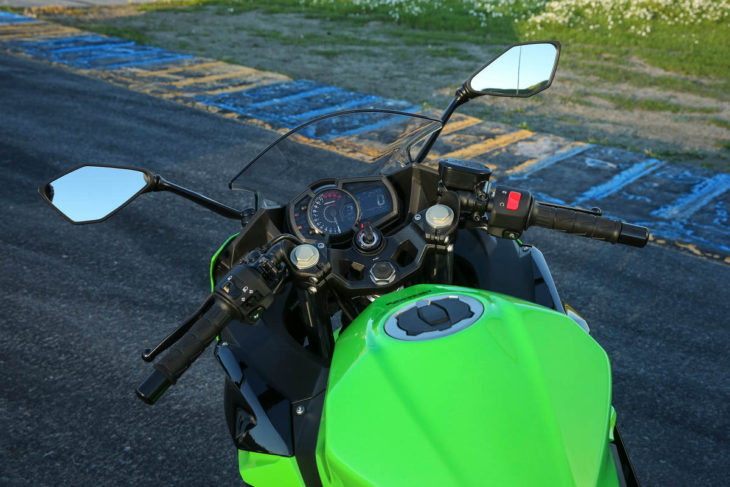
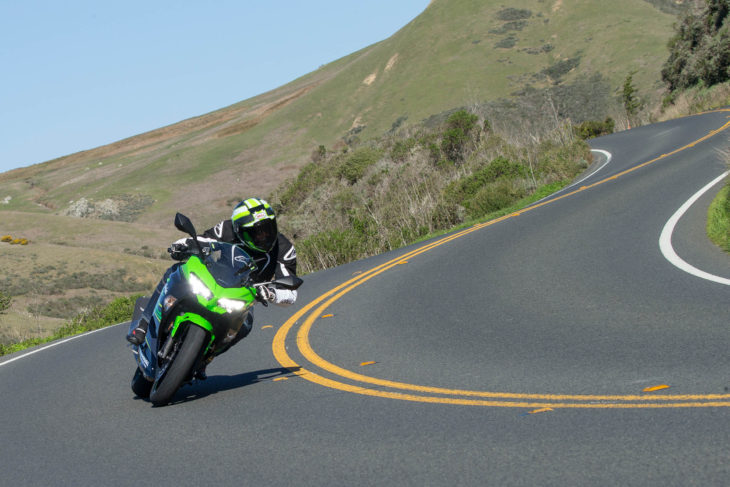
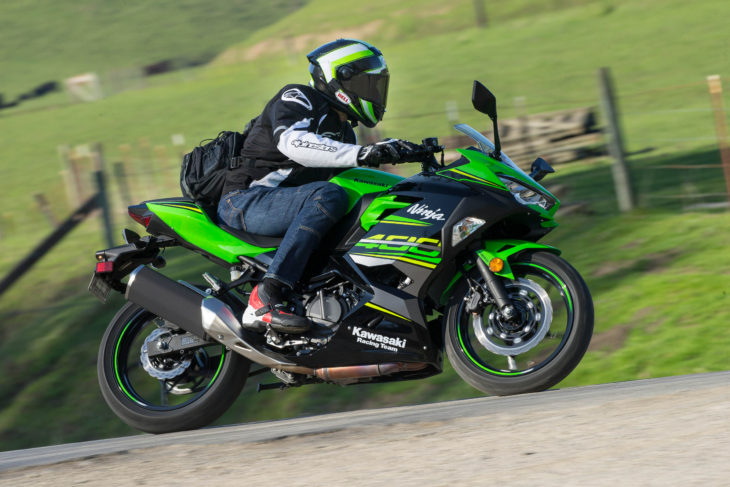
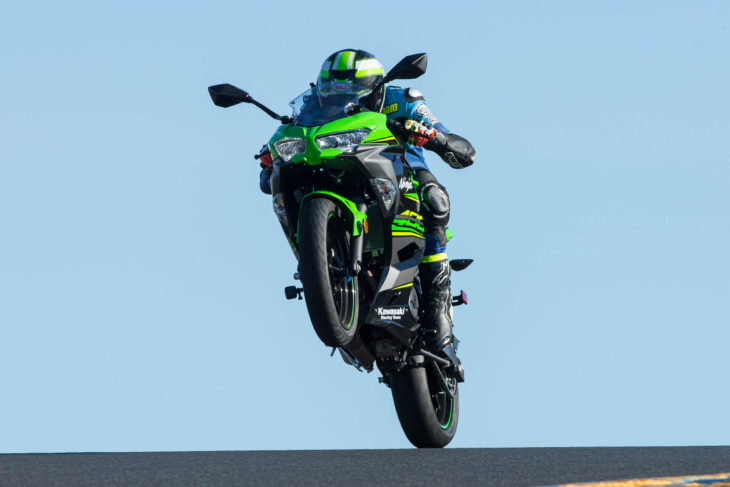
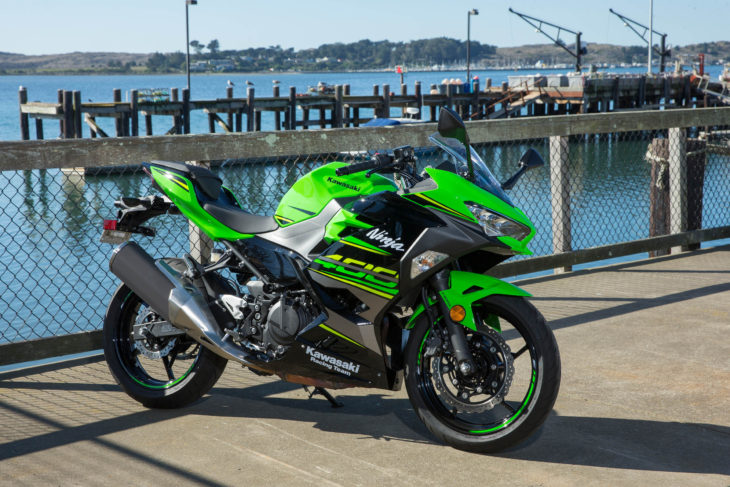
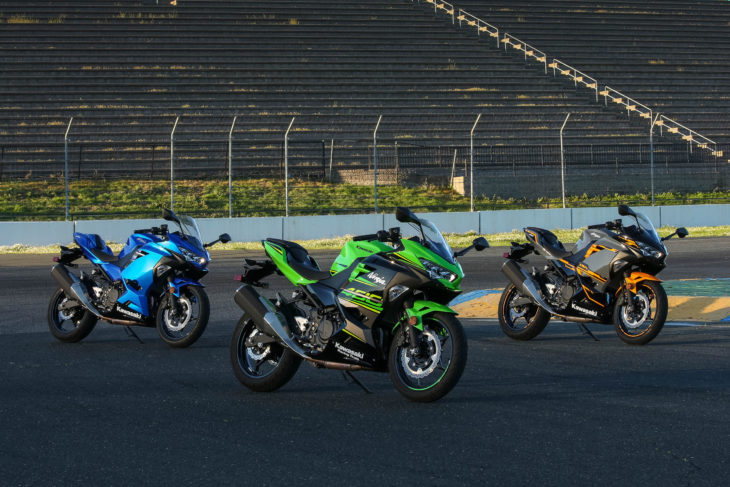
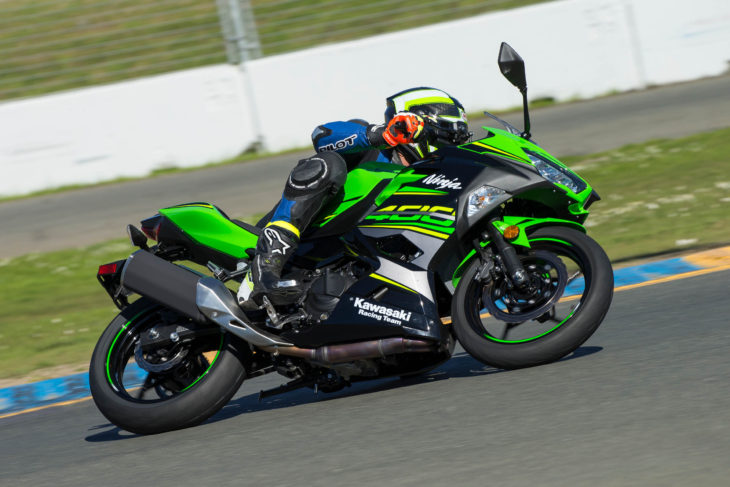
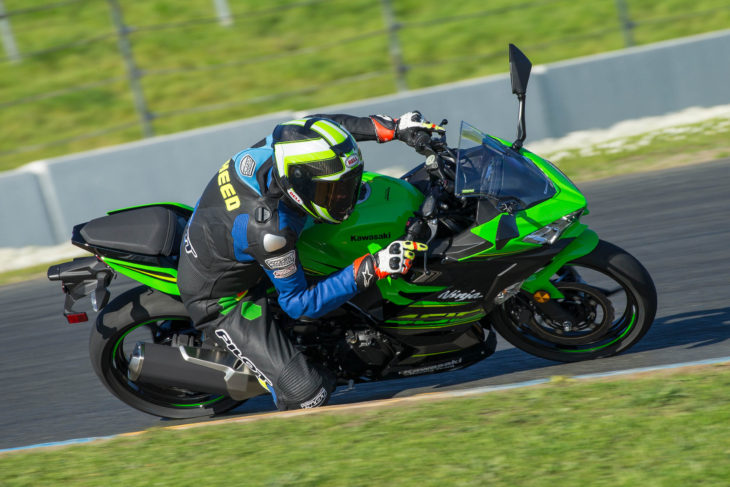






Actually I like that bold, bright 400 written across the faring. It let’s another biker know that he just got his butt kicked by a 400.
Let’s add just ooooone more cylinder to this little scoot : – )
This is fine like it is. Get ya’ a nice used Daytona 675r for the same price.
Thank you Kawasaki for keeping the trend of ugly mufflers….
Hardly their fault, is it?
“Don’t worry about the government”
Kawasaki nailed this one. It’s a bike that cuts across several demographics. At 56 years old I’ve migrated away from sport bikes due to excessive horsepower; moving from open class bikes to super sports and even a few singles. My DRZ400SM and a cafe racer I built are my favorites right now. I still like the riding position of a sporting bike (forward lean, feet up high) but find the bodywork of little value – it usually just causes buffeting at the lower part of my helmet. If Kawasaki sees it way to produce a Z400RS version of this bike, I’m 100% in. It would be a bonus if they treated the Z400RS like they did the Z900RS, giving it better brakes and suspension. Over the last 26 years of riding (nearly 30 motorcycles) I’ve only owned two new bikes; a TS-50 that my father purchased for me and my first street bike, a GN400. If a Z400RS comes to be, it will make number 3 on my new bike list.
The GN400 was always a fave of mine : – ) Simple, reliable, and pretty!
My buddy had a GN400 and could wheelie the heck out of that thing. That little Suzuki could take a beating and still run great.
at least with 41mm forks all the usual drop-in cartridges are easily possible. home-brew GSXR retrofits, Matris F15k (bargain), Ohlins NIX-22, Andreani etc. It’s about damn time.
Bring on the Versys-X 400. We are waiting.
The early info surrounding the Ninja 400’s development stated that the 300’s engine would not meet Euro4 compliance, so unless the Versys 300 was a poor seller in Europe, a Versys 400 is almost a certainty.
Mr Waheed Esq. is on Motorcycle Daily! Welcome 🙂
Quite possibly the perfect beginner bike, commuter bike, returner bike, old guy bike. Thank you Kawasaki. In 15 years this bike will trigger tears of nostalgia. “Why don’t they build them like the old Ninja 400 anymore?”
Love the bike overall, but I hate the #400 decals on the green kitted one. Do I get Kawi-bucks every month for advertising that the new Ninja is 400cc now, lol.
re: “Rather than a knock, one could argue that the mild buzz makes the riding experience more immersive— especially for those looking to experience the real flavor of motorcycling.”
UP YOURS BATTERY ELECTRIC VEHICLE…!!!
best comment of the week award!
Yes, let’s celebrate the unavoidable flaws as “flavor”. Ha ha!
Like many, I wish it was an inline four.
Then it would be a screamer like my FZR400 and Jamie Lee Curtis.
LOL I was like wow because I thought of A Fish Called Wanda first
Meh. A twin is a far superior choice and the Ninja 400 would mop the floor with the FZR.
By how much? The Ninja has 30 years of tech. The old FZR is standing tall from my piont of view.
The FZR was getting beat up 30 years ago by Honda and Kawasaki too.
Not sure which Honda and Kawasaki 400 models you are talking about or what market you are in because here in the US there were no other 400s that would touch the FZR400. The were no CBR400RR, VFR400R, ZXR400, or GSX-R400 imported to compete with it. Maybe you’re in Europe and had those models but we didn’t. I don’t believe the FZR400 would have much trouble with the new Ninja.
I would also LOVE to know which Hondas and Kawis (under 600cc) were beating up FZR400s? VF500’s in a straight line…maybe/maybe not…SV’s yes, but they are newer, bigger, and not Kawis or Hondas…
The FZR400 cost as much as a CBR600 or Ninja 600 which stomped the FZ into the ground.
The ONLY reason 400cc 4 cylinder bikes existed was due to Japanese licensing laws.
The 400s also existed because of F3 racing, where the FZR and the likes prove favorably.
The early 600’s were up-sleeved 400’s, which is why they cost the same. The 400’s never really came here because we didn’t have the licensing restrictions that make them appealing in the JP market against larger bikes.
!?!?! The FZR has 50% more power than the Ninja (64 vs 43). It’s hard to argue against an inline-four in terms of power and acceleration.
re: “I wish it was an inline four. Then it would be a screamer like my FZR400”
would you settle for the “buzz” of a 400cc Triple…? where a 4 cylinder still might be a “bridge too far” cost wise in this category, i wouldn’t be surprised if Yamaha responds to this displacement sweet spot with an R4 or MT04. in our usual manner of “wishful thinking” as consumers it’s being discussed on the interwebs.
think about it, they’ve already made a name for themselves with both the old FZR400 multi and the modern low cost FZ09 (now MT09) but ultimately the popular R3 at 321cc’s is going to need an update. Q1: so what to do then…? Q2: increase displacement to match the Zed…? or Q3: leverage their refreshed identity at building Triples, and create something semi-unique in the category…?
Sure. A triple may be a good route to go. Although I’ve never ridden one everything I hear seems favorable.
My original comment was nothing more than pining for the past. I don’t expect to ever relive any of my motoring past. Or purchase a new Yamaha with a 20 valve head, or a 400cc inline four, or front and rear swingarms.
Probably smart to stick with the twin. I had a ZZR400 in Japan 20+ years ago. The thing didn’t start making any power until the needle swept north of 10K RPM. Having a 16K RPM redline was a nice little trick that long ago.
Twins are torquier and therefore better for starts and hills and certainly less expensive for Kawasaki to produce. We should all be glad Kawasaki started this whole market segment of small, inexpensive sport bikes 30 years ago with the 250 Ninja. In Japan it has been a thing for at least that long. Honda has a gorgeous VTR 250 with a trellis frame there.
I think you are confusing “torque” with gearing. Sure, if the twin is geared lower, it will start up hills easier. Many fours are track focused and geared pretty tall in first. This isn’t an issue of torque. The FZR400 has 29 ft-lbs torque vs 28 for the Ninja 400. Fours always have more torque for any given displacement and they are much more powerful. If you want hard acceleration and greater pulling power, go for the four.
Twins usually make better street engines below 500cc. They can make decent power across a wider rev range.
That is a myth. Engines are designed and tuned to specific parameters. The more cylinders an engine has, the greater volumetric efficiency that engine has for a given displacement. That means a greater potential for torque, horsepower and the width of the power band.
Twins are cheaper and slimmer, two things that work well for motorcycles, and that is why we see so many of them. Twins are not capable of challenging fours for power which is why we typically see manufacturers tune them for more street friendly behavior. There have been 4’s tuned for street duty as well. Suzuki’s Bandit, the ZRX, BMWs K bikes to name a few.
Re: “The more cylinders an engine has, the greater volumetric efficiency that engine has for a given displacement.”
If it were true that a small displacement I4 had “greater potential for torque, horsepower and the width of the power band”, then there would be examples of such engines in the market place, but there aren’t, and never have been.
Honda used to make the CB450 and 450f (twin and 4). Most agreed that the twin was the better street bike because it had a more usable spread of power, if not quite the same amount at the top of the rev-range. The Bandit 400 and Honda CB1 were gutless below the upper register, despite being pitched as small all-around bikes. Sure, you could access power with revs, but if people wanted to ride that way, 400cc I4’s might still be available outside of markets where there aren’t displacement and power based license restrictions.
Dave, it is true. The reason you don’t see such engines is due to cost, not some exception to physics. There isn’t much point in building a 4 cylinder that behaves like a twin for maybe an 8% gain on 40hp or 25 lb ft of torque. That isn’t.
Please put this engine into a similarly affordable dual-sport!
I think 399 CCs is the sweet spot – small enough to keep you off the insurance company’s radar, big enough to be able to ride major highways comfortably. Kawi’s knocked this one out of the park. Not sure that I’ll buy one, but if I was starting out again today, this would really appeal, in a way the dated EX 500 didn’t.
Besides the KTM 390, this is the only other bike in the segment that’s just plain cool. I do love the idea of the Honda CB500F, but they went too far toward the beginning rider and thus killed the cool factor. If a bike isn’t cool (rad, bitchin, dope, solid…), young guys won’t buy it. I’d suggest they go a bit further and give us an R model because lots of experienced guys would surely pay another grand for a bit more bite.
I hope your right. Maybe Kawasaki can make the ‘Ninja’ brand cool again. Right now its sort of mocked by the hipsters
How do you know this and how and where is this mocking? Are you saying the Ninja name no longer sells?
Not to hipsters…no. I know this because up until a year ago I worked for a motorcycle company that does a lot of research…
Do hipsters buy new motorcycles? I thought they’d mock each other for not buying “vintage”..
Who cares what hipsters mock.
bmbktmracer does, he started the thread
So this is my fault… hahaha Truth be told, I never even considered hipsters. Just thinking about guys like myself who like cool stuff that works great. Like my Alpina watch or ’66 Ford truck. Couldn’t care less what others think of them.
I don’t understand how we got to this point. Back in 1997 I bought a new 1997 EX500 Ninja as my first bike. What caused the shift in the displacement standards? You had 250cc, 500, 600, 750 then anywhere from 900 to 1100.
It’s like they’re just coming back full circle.
It’s not just one factor, but many. Shifting market trends, a devalued dollar, changes in emissions laws, changes in European licensing like the A2 level, and need to drive sales in small affordable bikes to attract new riders who don’t have much money. The standards you’re describing are from a bygone era of steady to very good motorcycle sales and nearly constant growth ending in the early to mid 2000’s bubble that popped in 2008. The manufacturers didn’t need to innovate much because people were buying whatever they produced. Nobody bothered with small bikes like 250’s unless they were a beginner who didn’t want a 600. Not only are buyers more cautious with spending, but they’re smarter not wanting to start on a big bike. The formerly uber strong selling 600 supersport class is nearly dead getting too expensive at $12k+, replaced by midsize nakeds like the MT-07, MT-09, Z650 and Z900. I think this Ninja 400 is exactly what the motorcycle market needs more of. 250’s and 300’s are too small in most cases, anything bigger than a 500 is over $6000 and we already have 650 twins. Not to mention Honda’s 500 bikes aren’t exactly setting the world on fire.
re: “250’s and 300’s are too small in most cases”
tiny dancers.
This is the small sport bike we’ve been waiting for, besides Honda’s CBR250RR brought to the US bumped to a 350 or better but that’s another story. I’ve been wanting to buy a small displacement bike to have some fun and hone my skills on for years but never liked the Ninja 300 or R3 enough to buy one. Mostly they looked and felt cheap and would require too many aftermarket mods. The Ninja 400 finally looks like something I’d spend money on. I only see two issues preventing me buying one. First, I’ll have to wait. I assume demand will be high and prices higher. I’ll gladly wait 6 months to a year and avoid $1000+ dealer markup on a $5000 motorcycle. Secondly, do I get ABS or not? On a larger bike I wouldn’t think twice ABS is a must, but on this I may not need it. It would be mostly a street bike and I like having the safety net for errant Prius drivers, but if I decide to track it would I hate having ABS? If I was working on my braking skills I might. If I wanted to upgrade to a Brembo caliper/master it would be a problem. Hmm…
A markup on these $5000 motorcycles? No way. The Ninja 250/300 has been Kawasaki’s biggest seller in the US for years. I got my 2015 Ninja 300 with a $300 rebate that August.
As an entry level bike for those interested in sport riding this might be the ticket but why not build an entry level bike for those who aren’t? Ducati attempted this with their 400 cc Scrambler without an entry level price. The ninja shown here has about a 3 1/2″ shorter wheelbase. Which I suspect would make it a twitchy little beast.
I couldn’t see riding this in Texas. It’s to windy here and most of the roads posted for 75 aren’t exactly autobahn quality.
I would think fairings etc would help with the wind…. Also bikes in this class tend to look more the sport part than feel it (riding position etc).
Headwind, yes. Side winds… not so much.
Oh pish posh. I started on a 250 in SF so I know side winds
Okay.
I’ve never noticed much difference that I’d directly attribute to fairings or lack thereof but I do find sportbikes easier in wind than standards. I would think better aerodynamics would help, no matter which way the wind is blowing.
I have found heavier bikes of similar style to be easier in wind (VTR1000 vs SV650s). By virtue of light weight, this 400 might not be the easiest thing to ride across the plains, but that will be true of anything smaller/lighter.
Oh, and he said “pish-posh”. Tee hee..
I found mostly thru hard way (nearly knocked down couple of times) that there is quite a bit of problematic behind sensitivity to wind (rider to bike weight ratio, C of G, fairing shape and definitely steering geometry and length of wheel base). Then of course it would be snap if wind kept single direction, but it does not. In addition it may appear out of sudden and in discord with weather forecast.
Never know until you try 🙂
this Texan is game…lots of small displacement bikes riding around
I have a 300 Ninja but I know what I’m getting next. Thanks, Kawasaki.
I’ve been waiting for this bike all my life. The only drawback is that in waiting so long, I’ve reached 50 and I wonder if the ergonomics will be comfortable enough to satisfy me now. If I could take this motor and use the Suzuki GSX250 design, it would be the ultimate city / back roads ride. It very well may be now. I sure hope so, because at $4,999 I might buy two!
Do yoga, you wont have any problems. 49 here
Same here, just turned 50 and have loved the 250 ninja all my life. It was my first motorcycle love (1987 black and red with white wheels). I also do Yoga and have some back issues and it helps a lot. I worry most about leg room, so am thinking the “extended reach” seat for taller riders might help even though I am only 5’7″ with a 30 inch inseem. I remember my previous 250s being quite comfy though and the 400 looks decent as well. For terrorizing the back roads on a Sunday I think it will be perfect 🙂
Almost 50 myself. And I used to do yoga too. Well, until I got kicked out for just sitting in the back and watching the girls display their cracks in strange positions.
LOL. I do it at home with Youtube videos. MCN story got me started with Yoga with Adrienne. There tons of videos out there though.
Have someone at the dealership hold the bike upright while you sit on it, hands on the grips. Now let go of the grips. If you fall sternum first into the tank, the ergos suck, look elsewhere.
It won’t be long before folks start singin’ the blues about how Kawasaki shoulda made this a 500(499cc) and then in a few years they’ll start cryin’ about how the manufacturers should bring back 250’s. And round and round we’ll go.
That’s a great test – if you plan on doing all your riding at 10 mph or less.
burn
That cycle will go on forever, but Honda already makes a (lot less sexy 500 series) and there are still 250-300cc bikes out there. For that matter, there’s no better bargain than a used Ninja 250, ever. I’m way past the “I need the new paint scheme” phase. If a bike goes 0-16 in 5 seconds or 4.9999, I could care less. The next bike I buy will be 2nd to last.
Amen Austin ZZR 1200. I drive for a living, and getting out of a bus and onto my bike is not the same as it used to be!
kawatwo, one of my earliest friends bought the 87 Ninja when they first came out. I had a 81 Yamaha Maxim 400 and was also riding my Dad’s 85 Maxim 700 (which I still own along with a 99 YZF600r). Between the ability to whine the motor and the light
weight of the bike, he kicked my butt on most of our rides – not to mention the looks he got when we were parked. I always loved the original Ninja 250!
Although I liked the revision in 1988, it never drew me to think of buying one, but this one does. I can’t wait to see it in person. It sounds perfect for an aging rider. Bye Max…
A really good looking bike and great specification.
I’ve had a search online, and I’ve seen that the instrumentation of this bike is well worth a picture in this article. It looks like it belongs on a bike 2 or 3 times the price of this.
I have a 1989 RGV250 which is just thrilling, and whilst the performace of this isn’t quite on the same page, I think I’m gonna cash in when the prices of old two-strokes get truely ludicrous, and buy one of these with some of the money.
I know what you mean; I started on two-strokes with KH250 being the last one. There is no substitute to their raunchy sound of frivolously easy spun engine mixed with smell of burned oil. Absolutely intoxicating.
Four-stroke sound good too but it is not the same thing.
This is a nice bike. but where is the naked version? I hope the z400 makes it in time for summer. take 20 pounds of plastic off that thing would be a blast!
Probably more like 5lbs, eh?
That 2nd image from the top is bitchin! The 2nd image below it is nice too. Sweet! I’d love to ride this bike.
A proper adventure bike with this 400 motor shall be simply scrumptious.
“But what do you expect for a bike that costs as much as some mid-grade mountain bikes?” As a MTB nut, no. You’re pretty close to a Specialized S Works for this price, which is podium ready.
An S-Works full-suspension MTB runs $8,200, more than 50% more expensive than this Ninja. You can get a decent mid-level bike for the *difference* in price between this moto and the S-works.
Don’t get me wrong, I’m a cyclist too. Most of my bikes cost more than my motorcycle.
One guy’s ceiling is another man’s floor
Credit Paul Simon…
Heh I never knew that. Got it from the Beastie Boys myself. Ironically it’s on _Paul’s Boutique_.
To paraphrase an infamous ex-bike racer, “It ain’t about the bike”. Sure, you can spend 10k+ on a road or MTB but a better rider will still cook your goose on a vastly cheaper bike and pass you like you were going backwards. It’s the rider, always has been, always will be. Many motorcyclists suffer the same fate in the canyons when a good rider on a 300 cleans your clock on your blood red $15,000 Duc.
OK, well, I ride a Hard Tail on 29 x 2.6 tires…IIRC S-Works HT is low $6k range, only +12% v. this lovely 400.
Sorry for brief OT here…I built a bike comprising reliable, high grade Chinese carbon HT frame, Chinese carbon wheels, carbon crank, and good fully adjustable fork for <$4k.
A full suspension bike approximately equal to the S-Works you mention would cost <$5k, minus the S-Works exquisite panache, admittedly no small thang! The S in S-Works is for sex!
It's too bad you can't build your own new motorcycle with similar savings, something equal to a modern Ducati Supermono for the price of this 400.
Check YT for a guy who loped the vertical cylinder from his Ducati 848 Superbike twin, converting it to a modern 424cc "SuperMono." Dirk might like to do a page on the bike, maybe interview the builder.
“It’s too bad you can’t build your own new motorcycle with similar savings, something equal to a modern Ducati Supermono for the price of this 400.”
So true. I built my last road bicycle and have exactly what I want, without wasted parts. Bought a Triumph Daytona 675R and have thousands of dollars of parts in the garage that I took off when I bought it (lights, fairings, exhaust, rearsets, clipons, etc, etc). I wish motorcycle manufacturers would sell a frame and engine that you could build like a bicycle.
There was a modular motorcycle talk sometime ago, if I remember well there were a few things that doesn’t help it like different power engines needing different frames and other structural elements (opposite of human pedal power which is known), transportation regulations which are only considered for the whole vehicle and the possibility of buying parts from other manufacturers which factories obviously wouldn’t want. But sure I would like buying parts as I want. Cars have it but work with much greater volumes.
Same here! I know it’ll never happen (other than the occasional limited edition model with upgraded parts), but it sure is fun to think about being able to spec your own motorcycle by using a factory parts catalog…
I also wish you could buy a track-ready production bike without all the superfluous street equipment. Imagine ordering a standard Yamaha R6 – but it comes without lights, mirrors, passenger pegs, etc., but it includes a two-piece fiberglass fairing, sticky tires, steel brake lines, and a GYTR exhaust, right from the dealership.
They used to sell TZ250’s to the public like that. Good times…
Americans keep making bigger bikes, the Japanese keep making better bikes.
“If you’re a new rider, you’d be wise to spend the extra 500 bucks on the ABS version.”
So the Japanese manufacturers are still offering non-ABS models of bikes clearly expected to land in the hands of many beginning-level riders. Many will never hear the advice above, and will choose to save the $500 if that’s what it takes for the sales person to close the deal.
Are new cars even available without ABS?
As an experienced rider that would love to have one of these as a second bike, I’m happy to save $500 and go without ABS. Think there might be a few more guys like me too. That’s a pretty big savings on a bike at this price.
But I get your point.
Watching this may change your mind … or not:
https://www.youtube.com/watch?v=qgJoNk_24Yo
I’d recommend spending 5 minutes watching this to anyone who rides.
My turn of the century BMWs with the servo-assisted ABS actually increased braking distance on dry pavement. And the only thing HH pads did was make the ABS kick in a lot more often and with the same or worse braking distance.
.
But in gravel and wet pavement or downpours, the ABS was fantastic, keeping me in control and upright. I made plenty of others into believers by letting them slam on the brakes in the wet.
.
Even 10 years ago, the industry hit the point where 95% of riders couldn’t outperform ABS anymore. And now, especially with cornering ABS, don’t even try to outperform it. You’ll just embarrass yourself or worse.
.
Even a rudimentary system on the Ninja 400 will be better than, not just my 1100 BMWs but also the 1st gen 1200 BMWs that came out just after.
.
I’ve ridden since ’86 and have learned the value of ABS on any street bike, and now they don’t pulse so it feels normal. I’d have bought it on my Ninja 1000 were it available in ’13. I’ve been pretty successful so far with quite a few panic stoppies and front wheel skids.
“Standard ABS models start at $5,299” So without the fancy paint, ABS is only $300. But I agree it should be free, especially on a bike that will appeal to new riders.
It’s probably something peculiar, but on a long ride I am more comfortable with crotch rocket ergonomics than the straight up sort. (caveat, I always add Helli-bars). I think it’s because straight up bothers my lower back after a while.
Nothing is free. Would it seem free if there simply weren’t a non-abs bike for $300 less?
re: “Nothing is free.”
you tell ’em Dave.
What size rear tire?
I’ll stick with my 390 Duke for now.
Hoping they’ll offer a 500 Parallel Twin soon vs the 800 (which is WAY overkill for street)
130 Rear Tire, Single 320mm Disk, 55Hp, 330 lbs Wet w/ 3 Gal Tank
11.77:1 CR, 64mm Stroke, 55HP @ 10K, 40TQ @ 8500
First manufacturer to do this under $7000, out the door, gets my money
I echo what kawatwo says, it’s more fun riding a bike 100% than riding one 75%.
Michael P. – I agree. Of the 50+ motorcycles I have owned, I have had the most fun on smaller displacement bikes that I can ride to their limits. Which also happen to be my limits!
a steal at that price
How long before they figure there’s a gap between this and Z125 and we get a Ninja 250 again?
There’s alr eady a 250cc mono in production for Asian markets. The real question is when and if it’s going to be brought to other markets.
Hmm, not sure what to feel about a Ninja thumper.
$5000 is not a “mid-grade” mountain bike, in the same way that a 911 turbo is not a “mid-grade” car, just because porsche 918s exist!
Anyway kawasaki, put this engine in a new refreshed KLR 400!
Top spec Giant and Specialized mountain bikes sell for $10k…the point made in the article is entirely valid. We can argue all day about perceived value, but comparing apples to apples and motorcycles to motorcycles this baby Ninja is a great value.
I do think that part of the savings here is derived from the steel trellis frame. Personally, I’ve always liked the look and stiffness of the aluminum perimeter frames. I would have to ride the new generation of trellis framed bikes to see how they compare before I pass judgment.
re: “I would have to ride the new generation of trellis framed bikes to see how they compare before I pass judgment.”
just go with it, trust me.
I’m going to go out on a limb here and just assume that if a steel trellis frame is stiff enough for a 1290 SuperDuke, it will probably work just fine for a 400cc Ninja.
Just like on some bicycles a steel frame may give a more comfortable ride. I had a GSX1250FA and it had a steel frame, and it was buzz free.
This bike hits the bullseye better than any new sportbike in recent memory. For its target market, it covers all the bases, and it even looks great. If I was still a motorcycle dealer, I would sell the ever-loving crap outta this bike. This is the one I would point every new rider to, as well as every older rider who just wants a second bike to have fun on in the canyons.
I bet this little Ninja would be an absolute terror on everyone’s local equivalent to Mosquito Ridge.
Dirck, it seems you’ve really liked all the recent Kawasaki sportbikes you’ve reviewed: Z650, Z900, Z900RS, ZX-10, Ninja 1000, and now this Ninja 400. IIRC, you also gave good reviews to the Versys 650 and Versys 1000.
Kawi is on a serious roll.
I predict this will be Kawasaki’s best selling bike for 2018 🙂 For the street I think this is the perfect size unless you live in Texas or Montana 🙂 Being able to use all the throttle on a twisty road is what it’s all about and 366 pounds is perfect. 100 pounds lighter than my 2013 Ninja 650. LOL. I want one.
I doubt many people will be able to use all the throttle on a twisty road on this bike. – unless of course they’re in the wrong gear.
This motorcycle makes a lot of sense on several fronts. It seems that it will provide all the power and handling most riders, especially the younger ones, will be able to use on the streets. It certainly doesn’t look like a bargain basement bike, and the value is quite amazing. It should send Honda, Yamaha and Suzuki scrambling to catch up. Good marketing tool as well. Sell a new rider a quality bike at a good price and he/she may develop the brand loyalty all manufacturers desire. Well done, Kawasaki.
I know it’s apples and oranges, but it is hard to believe you can buy one of these for $3000 less than a Burgman 400 scooter. What a bargain.
You bring up a good point. I have wondered why scooters are priced at such a premium. I would have expected multiple affordable models with a few pricey ones.
Economies of scale, I’d guess that Kawasaki sells 10 little Ninja’s for every Burgman.
Globally, I’d find that hard to believe. Mid-size scooters are one of the most competitive moto-markets in Europe, which is about twice the size of the US market.
Still, great to see this bike. I hope they’re rewarded with big sales.